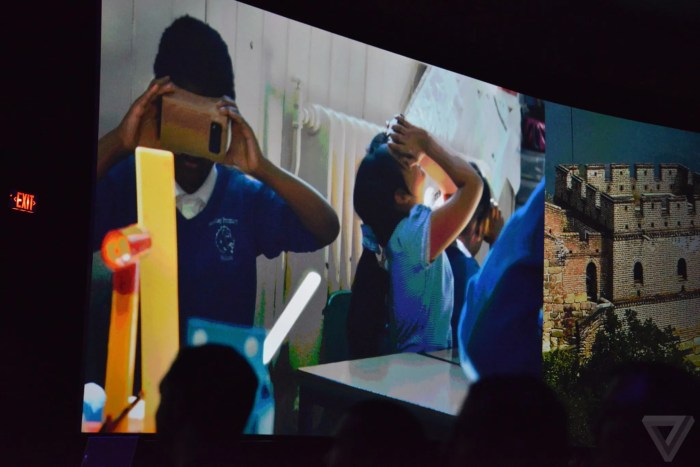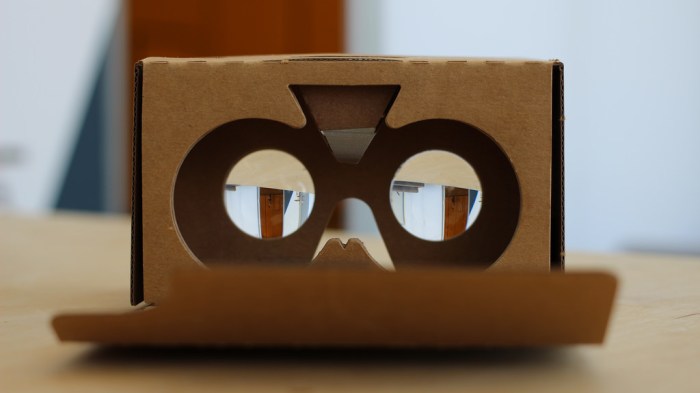Google’s Cardboard History
Google Cardboard is a virtual reality (VR) platform that uses a simple, inexpensive headset made from cardboard and a smartphone. It was launched in 2014 as a way to democratize VR experiences, making them accessible to a wider audience.
The journey of Google Cardboard began as a simple experiment, a testament to Google’s commitment to innovation and accessibility.
Cardboard’s Genesis and Initial Launch
Google Cardboard was first introduced at the Google I/O developer conference in 2014. The initial concept was simple: a foldable cardboard viewer that could be assembled by users and paired with a smartphone to create a basic VR experience. This innovative approach made VR technology accessible to a wider audience, breaking down barriers of cost and complexity.
Evolution of Cardboard Technology
Over the years, Google Cardboard has evolved significantly. The initial version was a basic viewer with a limited field of view. Subsequent versions introduced improvements like a wider field of view, magnetic buttons for interaction, and support for higher-resolution displays. The platform also saw the development of new features, such as the ability to track head movements with greater accuracy.
Cardboard’s Impact on the VR/AR Landscape
Google Cardboard played a pivotal role in popularizing VR experiences and fostering the growth of the VR/AR landscape. It helped create a significant buzz around VR and encouraged developers to create immersive content for the platform.
Cardboard’s accessibility paved the way for wider adoption of VR, making it a more mainstream technology. The platform served as a gateway for many users to experience VR for the first time, introducing them to the potential of immersive technologies.
Cardboard’s Influence on VR Development
Cardboard’s impact extended beyond its own platform. It influenced the development of other VR headsets, inspiring the creation of more affordable and accessible devices. Cardboard’s success demonstrated the potential of low-cost VR and encouraged other companies to explore similar solutions.
The “Tease” and Speculation
Google’s recent “tease” regarding Cardboard has sent ripples through the VR/AR community, leaving many wondering what the tech giant has up its sleeve. The company’s cryptic message, hinting at a new chapter for Cardboard, has sparked widespread speculation and anticipation.
Possible Directions for Cardboard
The “tease” has fueled numerous theories about the potential direction of Cardboard technology. While Google hasn’t revealed its plans, analyzing previous developments and current trends in VR/AR can offer insights into what might be in store.
- A Renewed Focus on Accessibility: Cardboard’s core strength has always been its affordability and accessibility. Google might be aiming to make VR even more accessible, perhaps by introducing new, even more cost-effective Cardboard viewers or partnering with budget-conscious smartphone manufacturers.
- Integration with AR: The lines between VR and AR are blurring. Google might be exploring ways to integrate AR features into Cardboard, allowing users to experience augmented reality content through their existing Cardboard viewers. This could involve partnerships with AR app developers or the creation of dedicated AR experiences for Cardboard.
- Emphasis on Educational Applications: Cardboard has already proven its value in educational settings. Google could be focusing on expanding its educational offerings, perhaps by developing new interactive learning experiences or partnering with educational institutions to create tailored Cardboard-based curriculum.
- Focus on Specific Niches: Google might be targeting specific niches within VR/AR, such as healthcare, manufacturing, or training. This could involve developing specialized Cardboard viewers or applications for specific industries.
Potential Applications and Use Cases: Google Teases Cardboard News
A revived Cardboard platform could tap into a wide range of applications, leveraging its affordability and accessibility to make VR experiences more readily available to a wider audience. Its potential goes beyond entertainment and extends to various sectors, including education, healthcare, and training.
Education
Cardboard’s affordability makes it an ideal tool for educational institutions seeking to incorporate VR into their curriculum. The platform can be used to create immersive learning experiences, allowing students to explore historical events, scientific concepts, or even distant planets in a way that traditional methods cannot replicate.
- Virtual Field Trips: Cardboard can transport students to historical sites, museums, or natural environments, offering an interactive and engaging way to learn about different cultures, historical events, or natural phenomena.
- Interactive Learning Environments: Cardboard can be used to create interactive simulations, allowing students to learn by doing. For example, students can practice surgical procedures in a virtual environment, learn about anatomy by dissecting virtual organs, or build virtual structures to understand architectural concepts.
- Accessibility: Cardboard’s affordability makes it accessible to schools with limited budgets, enabling them to provide VR experiences to a wider range of students.
Healthcare
Cardboard’s potential in healthcare extends beyond traditional medical training and extends to patient care and rehabilitation. Its affordability and accessibility make it a valuable tool for various applications.
- Patient Education: Cardboard can be used to create interactive simulations that explain medical procedures, conditions, and treatments to patients in a more engaging and understandable way. This can help patients feel more informed and empowered in their healthcare decisions.
- Pain Management: VR experiences using Cardboard can help distract patients from pain, reducing their reliance on medication. This can be particularly beneficial for chronic pain management and post-operative recovery.
- Rehabilitation: Cardboard can be used to create VR games and exercises that help patients recover from injuries or illnesses. For example, patients with stroke can use VR games to improve their hand-eye coordination and motor skills.
Entertainment
Cardboard remains a viable option for entertainment, especially for casual users seeking affordable VR experiences. While it may not offer the same level of immersion as high-end VR headsets, Cardboard can still provide engaging and enjoyable experiences.
- Gaming: Cardboard can be used to play VR games, offering a more immersive and interactive gaming experience than traditional games. This can be particularly appealing to casual gamers who want to try VR without investing in expensive hardware.
- 360° Video: Cardboard can be used to watch 360° videos, allowing users to explore different environments and perspectives. This can be a fun and engaging way to experience travel, nature, or even music videos.
- Virtual Tours: Cardboard can be used to take virtual tours of museums, art galleries, or other attractions, providing an immersive and interactive way to experience these locations.
Training and Development, Google teases cardboard news
Cardboard can be a valuable tool for training and development, offering a cost-effective and engaging way to simulate real-world scenarios.
- Safety Training: Cardboard can be used to create VR simulations that train employees in safety procedures, such as fire safety, emergency response, or hazardous material handling. This can help employees learn and practice these procedures in a safe and controlled environment.
- Customer Service Training: Cardboard can be used to create VR simulations that train employees in customer service scenarios. This can help employees develop their communication skills, empathy, and problem-solving abilities in a realistic and interactive setting.
- Sales Training: Cardboard can be used to create VR simulations that train employees on sales techniques, product knowledge, and customer interactions. This can help employees develop their sales skills and confidence in a virtual environment.
Market Analysis and Competition
The VR/AR market is experiencing explosive growth, driven by advancements in technology and increasing consumer interest. This burgeoning industry is attracting significant investment and the entry of numerous players, making it a highly competitive landscape.
Major Players and Offerings
The VR/AR market is dominated by tech giants like Meta (formerly Facebook), Google, and Microsoft, each with their own unique offerings and strategies. Meta, with its Oculus brand, leads the market with its high-end VR headsets like the Oculus Quest 2. Google, on the other hand, focuses on accessibility with its Cardboard platform and Daydream VR, while Microsoft’s focus is on enterprise solutions with its HoloLens mixed reality headsets. Other notable players include HTC, Sony, and Valve, all contributing to the diverse VR/AR ecosystem.
Competitive Landscape for Cardboard
Cardboard faces stiff competition from both mobile VR headsets and standalone VR devices. Mobile VR headsets, like Samsung Gear VR and Google Daydream View, offer a more immersive experience than Cardboard, with better tracking and higher-resolution displays. However, these headsets are often more expensive and require compatible smartphones. Standalone VR devices, like the Oculus Quest 2, offer the most immersive experience, with complete freedom of movement and no need for a smartphone. These devices are, however, the most expensive option.
Cardboard’s Niche
Despite the competition, Cardboard still holds a unique position in the market. Its low cost and accessibility make it an ideal entry point for users interested in exploring VR. Cardboard’s simplicity and ease of use, coupled with its ability to be customized and repurposed, make it a popular choice for educational and entertainment applications. Cardboard’s focus on affordability and accessibility has allowed it to carve out a niche in the market, catering to a specific audience seeking an affordable and accessible VR experience.
Google teases cardboard news – The whispers of Google’s Cardboard revival have ignited a fire in the VR community. Whether it’s a complete reboot or a subtle update, the potential for Cardboard to democratize VR once again is undeniable. With its focus on affordability and accessibility, Cardboard could breathe new life into the VR landscape, driving innovation and creating new opportunities for both developers and users.
Google’s recent tease about Cardboard news has us wondering if they’re about to shake up the VR world again. Maybe they’re planning on bringing news to life with immersive experiences, or maybe they’re just making a playful nod to the past. Whatever it is, it’s a reminder that innovation is always happening, even when it seems like everyone’s focused on issues like the Samsung Note 7 recall.
So buckle up, tech enthusiasts, because Google’s Cardboard news might just be the next big thing.
 Standi Techno News
Standi Techno News

